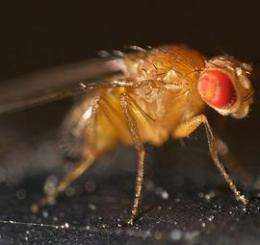Study points to enhanced detection of Parkinson's

New research by biologists at the University of York could lead to improved methods of detection for early-onset Parkinson's Disease (PD).
Recording the responses of fruit flies (Drosophila melanogaster) to different visual patterns, using methods adapted from the study of vision in humans, scientists in York's Department of Biology investigated the nervous systems of flies with different types of Parkinson's mutations.
Funded by the Wellcome Trust, researchers compared flies carrying mutations associated with early-onset Parkinson's with 'normal' control flies, and found increased neuronal activity to stimulation in the former group in 'young' flies.
By mapping the visual responses of fruit flies with different Parkinson's genes, the scientists built a substantial data bank of results. Using this they were able to classify unknown flies as having a Parkinson's related mutation with 85 per cent accuracy.
Researchers believe it may be possible to transfer this method back to the clinic where early changes in vision may provide a 'biomarker' allowing screening for Parkinson's before the onset of traditional motor-symptoms. Therefore, profiling human visual responses could prove an accurate and reliable test in diagnosing people with early-onset PD.
This method is also likely to succeed when transferred to human detection of Parkinson's, as visual profiling in humans has proved accurate in the past in detecting genetic markers. In this study, as more complex light stimulations have been used, a more accurate picture of detecting a wider variety of different genetic markers has been revealed.
Dr Ryan West, Postdoctoral Research Scientist in York's Department of Biology and Lead Author on the study, said: "Increased visual activity in young fruit flies with early-onset Parkinson's mutations is a significant finding, as it may provide an early-onset biomarker for people at risk of Parkinson's.
"Using 64 different combinations of visual stimuli, we now have a comprehensive bank of the reactions of fruit flies carrying different genetic mutations. We can see that fruit flies carrying different mutations have distinct patterns of visual responses, suggesting this is a reliable method in classifying Parkinson's genotypes.
"We hope this method may be translatable to the clinic where changes in vision may provide an early indication of early-onset Parkinson's. Such early detection is essential if we are to understand disease progression and develop novel therapeutics."
More information: Ryan J.H. West et al. Classification of Parkinson's Disease Genotypes in Drosophila Using Spatiotemporal Profiling of Vision, Scientific Reports (2015). DOI: 10.1038/srep16933
















